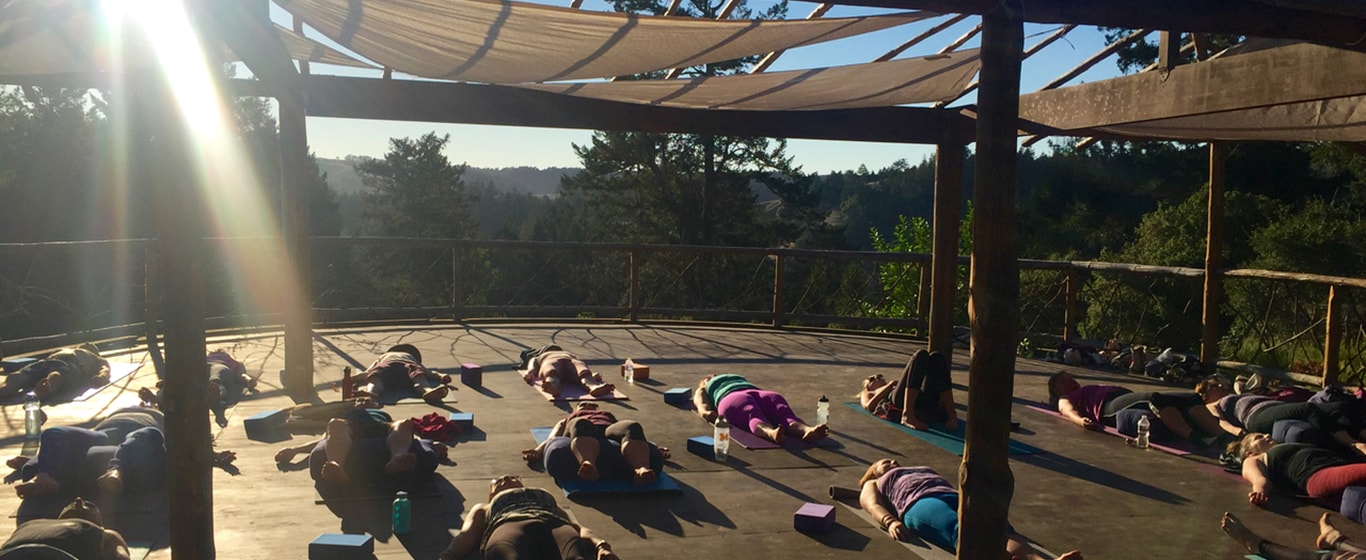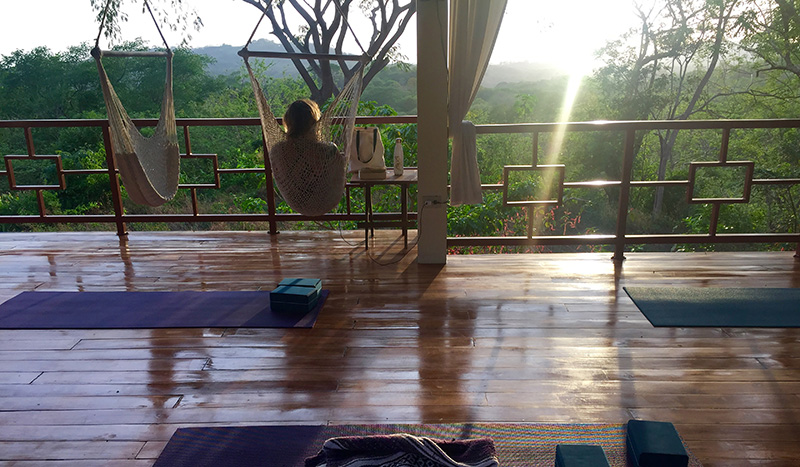
Did you know that meditation can literally change the grey matter in your brain, and enhance cognitive and psychological behaviors?
According to a recent study conducted by Harvard researchers, "meditation rebuilds the brain's grey matter in just eight weeks".
That's not eight weeks of sitting alone in a dark cave or on a rock in the middle of the ocean, meditating for hours every day. Just 20-30 minutes of meditation per day could achieve this rebuilding of the brain.
I used to think that the purpose of meditation is to relax, reduce anxiety and calm our minds. Well, I was on the right track to some extent because meditating does relax us and can ease anxiety. That said, the relaxation that we often feel when we meditate is merely a byproduct, and is not the actual purpose of meditation.
I was introduced to meditation at a time in my life when I was experiencing a lot of anxiety. My very first meditation class was in New York City at a Buddhist Meditation Center. I was definitely apprehensive and wondered if I would be the only person there that wasn't a Buddhist monk and an advanced meditator. To my pleasant surprise, the room was filled with around 150 other young New York City professionals just like me, living a high stress life in the city that never sleeps.
During that first meditation class, I felt my whole body melt into the chair. The knots in my stomach began to disappear and the aching in my legs also began to disappear. In fact, I felt like my whole body disappeared for a short time during the guided meditation. I was awake and alert but my whole body felt like it was no longer there. Wow. From that moment, I knew I was onto something. I wanted to more of this.
I was feeling very relaxed and was also very focused on what the teacher was saying because it all seemed to make a lot of sense. I realized that I was not alone, and that others felt the same way that I did, and many even felt worse. This in itself was a comfort.
Although I felt relaxed and focused, two of my intentions for attending the class, I learned that the purpose of meditation is actually to understand and train the mind.
This sounded like hard work!
However, I was so focused on every word the teacher said, that I just soaked up everything, agreed with everything he said, and my inner voice told me I was in the right place and on the right path.
We learned about the concept of 'attachment' and letting go of our attachments to things, good or bad. One girl asked 'I feel like I am becoming attached to coming to this meditation class because it makes me feel better. Could this be considered an attachment?' The teacher smiled and said 'Well, there are worse things to become attached to. Seriously though, I hope you are getting something more out of meditation than it just being another attachment.'
That was an important statement for me. I could see how I might become attached to just coming to this class, listening to the wisdom and teachings of this inspiring teacher, and feeling part of a community. I realized that finding something deeper within my own meditation practice was going to be key, and certainly a practice.
So coming back to the purpose of meditation...
The purpose of meditation is to understand and train our mind, and to reach the meditation state, which is our natural state of inner peace and joy.

When we quiet the mind and focus on our breath, we begin to notice our thoughts and how active our mind is. This mind activity is part of the human condition and often these thoughts can be negative or delusional. This is the first step in understanding and bringing awareness to our mind.
Once we have this inner awareness and notice all the thoughts and activity constantly going on in our mind, we can begin to train the mind, just like we train our bodies through physical exercise. When working with a personal trainer, they ask about our current physical state of health and fitness, so it's important to understand the current state of our mind before we begin the meditation training.
To train the mind we are not necessarily looking to change our thoughts. They key is to notice the thoughts, and any emotions that may arise as a result of the thoughts, try not to become attached to the thoughts, try not to identify with the thoughts as being part of you or who you are, and change our reaction to the thoughts and emotions. In this way, it has been proven, as shown in the Harvard study mentioned above, that this training of our minds during meditation can literally change our physical body and brain over time.
When we train the mind in this way to let go of attachments to the thoughts during meditation, we begin to experience less thoughts, and more stillness in the mind. From this place of stillness in the mind, we begin to tap into our inner intuition, our inner self, which is already peace and happiness. Our true state is actually peace, happiness, joy, love, compassion. Once we lose our attachments to our thoughts and cease identifying with our thoughts as being who we are, we find ourselves settling into our true nature, inner peace, undisturbed by our thoughts or by situations around us.
After only a few weeks of practicing meditation daily and attending these weekly meditation classes, as well as feeling even more relaxed and more focused, what fascinated me the most was that the chronic physical pain that I had been experiencing for a few years prior to that was beginning to reduce. The power of my mind was helping to heal my physical body and eliminate physical pain.
It wasn't always easy. Often finding 20-30 minutes a day was a challenge, or my mind was so busy that it didn't want to stop and be still. Perhaps I was a little afraid of what would happen, maybe I would not feel good or wouldn't be able to do it. I found that like anything, it's a practice and some days are better than others. When I did make time to sit still and meditate though, my focus was almost entirely on my breath and I would lose sense of my body. I wanted to stay there forever.
I once asked a Buddhist monk what it meant that I sometimes lost sense of my body. He smiled and said 'That's a good sign. Keep doing what you are doing.' And so I did.
If you are interested in beginning a meditation practice, or exploring new ways to meditate, here are a few meditation tips that I'd like to share with you. I hope you find these helpful.
Find a comfortable seat somewhere that you won't be disturbed for the duration of your meditation. Set a timer on an alarm clock or on your phone. That way, you won't be tempted to check the time to see how long you have left. If you're using your phone for the timer, switch it to airplane mode so you won't hear any calls or emails come in.
Make sure your spine is straight, by sitting up nice and tall. You can have your back against the back of the chair so you are supported, if that works better for you. Place your hands either on your thighs or in front on your lap, one hand resting on top of the other hand. Lengthen your spine and let the back of your neck be nice and long and the crown of your head reach towards the sky. Close your eyes.
Bring your awareness inward to your body and notice the parts of your body touching the seat or the floor, whatever you are sitting on. Feel the support of the earth under your seat and the support of the floor under your feet if your feet are on the floor. Feel grounded to the earth. Begin to relax your jaw and the muscles in your face. Relax your shoulders away from your ears. Relax your legs and hips. Scan your body and notice if you are holding onto any tension in any part of your body, and consciously relax that area, keeping the spine long and tall.

Begin to notice your breath. Notice how slow or fast you are breathing. Notice how deep you are breathing. Are you breathing into the chest or into the belly, or both? Notice which parts of your body are expanding and moving as you breath. Notice if you are breathing in and out through the nose or the mouth. Just notice all this, without judgement and without changing it yet. Notice the sensation of your breath at the tip of your nostrils if you are breathing in and out through the nose, or inside your mouth if you are breathing in and out through your mouth.
Now begin to slow down your breath if your breath does not feel slow or relaxed, and maybe begin to slowly deepen your breath so you are breathing into the belly and not just into your chest or lungs. Let your breath feel relaxed and soft, and not forced.
Try to keep your mind on this single-point focus of your breath. Since the breath is always happening right now in the present moment, we use the breath as the 'object' for our meditation, to bring us into the present moment. The breath is also a helpful object to use because it's a way to connect our mind with our body.
"During a laboratory study, scientists discovered that when one-pointed attention is strong, the nervous system kicks into a relaxed mode, the heart-rate slows, metabolic rate declines, digestion picks up, and the brain activity associated with worry and agitation goes into neutral." ~ Mark Epstein, Advice Not Given, psychiatrist and author,
If any thoughts come into your mind, visualize the thoughts being like clouds in the sky, drifting in and drifting by. Be a watcher of the thoughts, as if you are separate from the thoughts. Do not identity with the thoughts as being you. Do not attach yourself to the thoughts or create a story out of the thoughts in your mind. Just notice the thoughts in a non-judgmental way, and gently bring your mind focus back to your breath, your meditation object, which is neutral with no judgement good or bad, right or wrong.
Now that you are beginning to understand and notice all the thoughts and activity in your mind, you are ready to begin training your mind! One aspect of training the mind, that we already talked about, was to bring the mind to that single point focus, the breath. We can also train our mind by bringing our focus now to a virtue such as love, kindness or compassion. This method of meditation is called placement meditation whereby we place our mind focus on a state of mind we would like to manifest.
An example of meditating on love would be to first try to manifest the feeling of love within your heart. Feel the love as if you are overflowing with love. The love is lighting up your heart and your soul. Then think about someone in your life that you would like to feel more love for, and visualize sending some of the love in your heart to that person. Feel more love for that person that you have ever felt before.
This might be challenging at first, so it's helpful to begin with someone who you may already love or have some connection with. Build up to sending love to someone who you may have some conflict with, or you may dislike for some reason, and then build up to sending love and feeling love for people you don't even know, passers by in the street, people you see in the news, on TV, people you've never met or seen, and every living being on this planet.
Hold this state of love for as long as you can, ideally for the remainder of your meditation. If your mind starts to wander, just notice that it's wandered, don't judge it, don't be frustrated, just gently bring the mind back to the virtue on which you are meditating, your meditation object.
Remember, we are training our mind to let go of the attachments, judgments and delusions such as anger, fear, anxiety, so that we can come back home to our natural state of being, which is our inner self, inner peace, joy, happiness, love, irrespective of what is happening around us. The well practiced yogis always remain calm and equaninous even when faced with challenges. Taking action from this place of calm, equanimity and wisdom is a lot more effective than taking action from a place of fear, anxiety or anger.
Training the mind in this way is a lifelong practice, so be kind and compassionate with yourself, don't be attachd to the end goal, and always remember to enjoy the journey!
When your alarm goes off, begin to softly relax your concentration and bring your mind back to your breath, then slowly begin to open your eyes and move your body gently. Notice how you feel in your body and in your mind. Notice anything that may have come up for you. You may want to just sit and relax for a while, or perhaps journal about your experience.
Oftentimes, when we meditate, things can come to us as if they are voices of clarity and reason, helping us to make a decision or to find more peace within ourselves. Whatever happens, do not judge, just allow it all to happen, and set the intention to come back to your meditation tomorrow!
Through practicing daily meditation, I find that I have more clarity about the journey I am on in my life, and my purpose has become clearer. My meditation practice continues to evolve as I meditate on the my breath and on different virtues or passages from spiritual texts.
I encourage you to tap into what feels right for you in your meditation practice. There are no specific rules. These are just guidelines above to help you get started. Allow your meditation to be yours, unique to you. The key is to not feel frustrated if your mind starts wandering, and not to judge yourself or be hard on yourself. Let go of these attachments to perfection, and enjoy the journey of finding deeper relaxation and training your mind to cultivate your natural state of peace and joy.
Remember, just 20-30 minutes of meditation per day will literally change the grey matter in your brain! You can even start with 5-10 minutes per day if that is all you can do. Take it slowly, and before you know it, you will be looking forward to your daily meditation practice and you will naturally be able to stay longer in your meditation.
Feel free to follow along with my 12 Minute Guided Breath Meditation or 12 Minute Inner Peace Meditation and get a taste of meditation yourself.
During our Weekend Yoga Retreats around beautiful Sonoma wine country, I lead guided meditations that are often theme-based, and may include intention setting or letting go of the past. We hold retreats over the solstices and equinoxes, which are powerful times in Astrology to tune into our intuition and inner voices more easily and set intentions for the new season.
Feel free to share any meditation experiences or questions in the comments section below. We'd love to hear from you!
Please also share this article with your friends on social media if you found it helpful, by clicking the buttons below.

Author: Sally Mitchell, founder of Body Flows Yoga Retreats and RYT 200 Yoga Teacher leads yoga retreats in California, Colorado, Hawaii, Mexico and Costa Rica. Living in beautiful Sonoma, California, after 15 years in NYC and San Francisco, her approach as a leader and teacher is holistic, balanced and grounded. She enjoys practicing and studying Yoga and Buddhism, hiking and trail running in nature, traveling, writing and inspiring others to live a more spiritual and meaningful life.